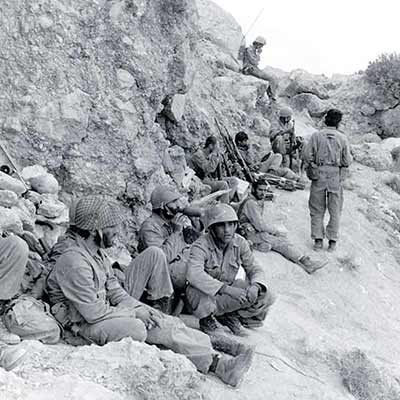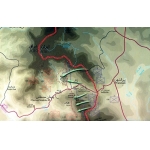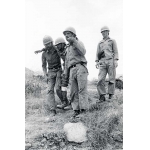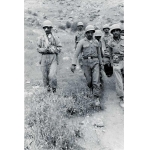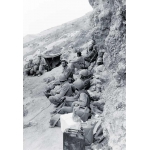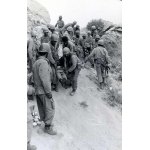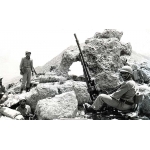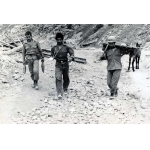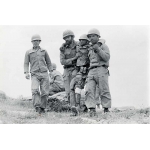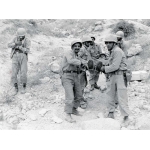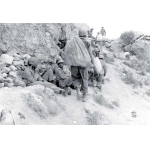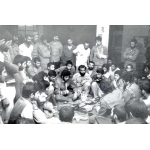Battles
Operation Bazideraz
Marziyeh Abedini
256 Views
Operation Bazideraz was carried out in 1981 with the coordination of the Islamic Republic of Iran Army and the Islamic Revolutionary Guard Corps (IRGC) in the Bazideraz Heights, located between Qasr-e Shirin, Gilan-e Gharb, and Sarpol-e Zahab.
On April 22, 1981, the operation was launched on the Western Front. Its objective was to neutralize the Iraqi army’s surveillance and dominance over the cities and areas of Qasr-e Shirin and Sarpol-e Zahab.[1]
During the Iran-Iraq War, three operations were conducted in the Bazideraz Heights. The first operation took place on March 1981, with no significant results. The second launched on April 22, 1981, and the third operation, known as Operation Martyrs Rajaei and Bahonar, was conducted on September 2, 1981.
The impassable Bazideraz Heights with high peaks and steep slopes were a major obstacle for any military unit movement and held strategic significance in the border region of Kermanshah Province. Forming a large barrier within the Qasr-e Shirin–Gilan-e Gharb–Sarpol-e Zahab triangle, these mountains provided comprehensive surveillance and control over the entire area, especially towards the north, east, and south. In addition, the topography prevented military support in terms of logistics and artillery planning. After its seizure, the Iraqi forces used this area to carry out reconnaissance missions, creating significant challenges for the 3rd Brigade of the 81st Army Division and the movements of vehicles through the passageways of “Kal Davood” and “Mian Kal” on the Pataq–Sarpol-e Zahab Route.
Due to the strategic nature of these heights, the Iraqi army decided to construct roads in order to facilitate the deployment of its units. Iraq built roads on peaks 1050, 1100 (north and south), and 1150, leveraging its advantage in surveillance and artillery fire control. The Iraqi forces also built an asphalt road connecting the Qasr-e Shirin–Gilan-e Gharb Route to the western foothill of peak 1150 in Bazideraz and named the observation post on this peak “Saddam”.[2]
In early 1981, the Iranian armed forces decided to take more serious measures to push back the invading Iraqi forces. The IRGC reconnaissance units observed the area for three months.[3] Eventually, the 9th Battalion of IRGC, along with the 143rd Mechanized Battalion of the 3rd Brigade of the 81st Division, an airborne company supported by Army Aviation helicopters,[4] and Basij and Kurdish Muslim Peshmerga units, devised the first semi-large-scale operation in the region, named Operation Bazideraz.
The operation was led by the IRGC Westen Headquarters and Army, with the primary mission of attacking the heights leading to peaks 1050, 1100 (north and south), and 1150 of Bazideraz to capture them and destroy the Iraqi forces.
According to the operation’s strategy, known as “Mohsen”, four combat groups named Ajdar, Babr, Palang, and Shir were assigned to attack from four fronts with full Army Aviation support. These groups consisted of IRGC infantry forces and the Army Special Forces.[5]
On the second day of the operation, Iraq attacked the units stationed in Kureh-Moosh and Qaraviz. Consequentially, the commander of the 3rd Brigade of 81st Armored Division, had to airlift his troops in that region. In addition, Captain Adabian, who was leading the operation, was martyred.[6]
By the end of the operation, which continued until April 30, 1981, peaks 850, 900, 1000, and 1100 (north) of Bazideraz Heights were liberated. Moreover, approximately 1,000 Iraqi soldiers were killed, and around 700 were captured by Iranian forces.[7]
In the early morning hours of April 28, 1981, the 7th Armored Division of Iraq launched an offensive to retake its positions in the Bazideraz Heights but faced strong resistance from Iranian forces. After losing a significant number of tanks and personnel, the Iraqis were forced to retreat. During this attack, the helicopter of Captain Ali Akbar Shiroudi, an Army Aviation pilot, was shot down by enemy fire resulting in his martyrdom and his co-pilot being injured.[8]
Throughout the operation, the Iraqi army launched seven major counterattacks across the entire defensive region. However, the Iranian forces, despite the lack of reinforcements, successfully repelled these counterattacks using heavy artillery, anti-tank fire, and air support, particularly from the Army Aviation unit. Finally, they managed to relatively achieve their pre-defined objectives.[9]
Every year in May, a commemoration ceremony is held at Bazideraz Heights, honoring the sacrifices of the Iranian forces during the Eight-Year Sacred Defense. This event is attended by many veterans, Rahian-e Noor Caravans, Basij forces from across the country, and devoted people from all over the Islamic Republic of Iran.[10]
[1] Darvishi SeTelani, Farhad, Ruzshomar-e Jang-e Iran va Iraq (Chronology of the Iran-Iraq War), Ketab-e Sizdahom: Tadavom-e Eshghal va Bohran (Continuation of Occupation and Crisis), Tehran: Sepah-e Pasdaran-e Enqelab-e Eslami, Markaz-e Asnad va Tahqiqat-e Defa Muqaddas, 1398, p. 525.
[2] Ibid., p. 541.
[3] Ibid., p. 525.
[4] Alaie, Hussain, Ravand-e Jang-e Iran va Iraq (The Course of the Iran-Iraq War), Vol. 1, Tehran: Marz o Bum, 1391, p. 308.
[5] Darvishi SeTelani, Farhad, Ruzshomar-e Jang-e Iran va Iraq (Chronology of the Iran-Iraq War), Ketab-e Sizdahom, p. 525.
[6] PurDarab, Saied, Taqvim-e Tarikh-e Defa Muqaddas (Chronological History of the Sacred Defense), Vol. 9: Zarbeh-haye Pey dar Pey (Successive Blows), Markaz-e Asnad-e Enqelab-e Eslami, Tehran, 1387, Pp. 54–55.
[7] Darvishi SeTelani, Farhad, Ruzshomar-e Jang-e Iran va Iraq (Chronology of the Iran-Iraq War), Ketab-e Sizdahom, p. 22.
[8] Ibid., Pp. 639–640.
[9] Ibid., p. 308.
[10] Ibid., Pp. 240–241.




